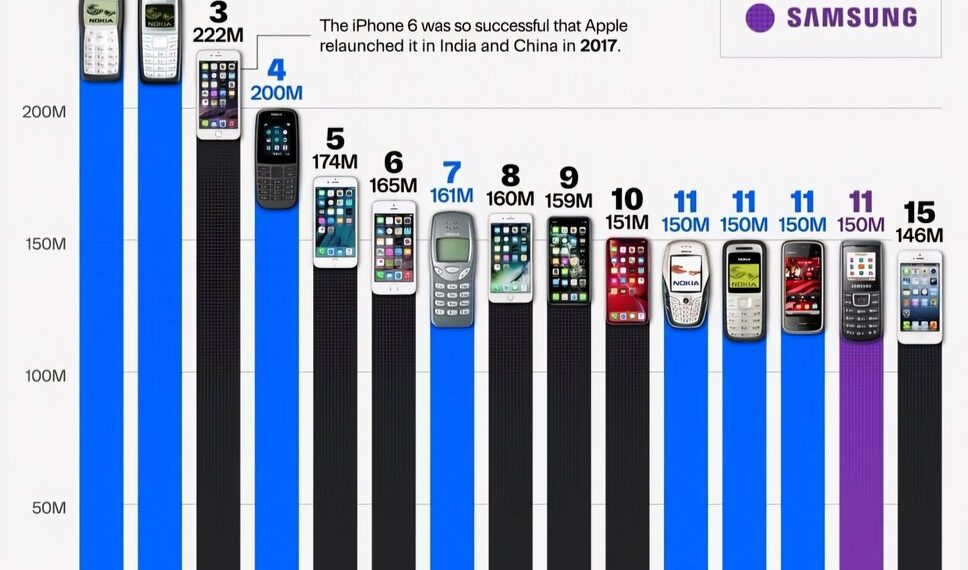Select Language:
The Most Sold Mobile Phones in History: A 2025 Overview
The iPhone 6 and 6 Plus: Pioneers of Mass Adoption
Image Source: Twitter
When discussing mobile phones with the highest sales, the Apple iPhone 6 and 6 Plus stand out as true game-changers. Released in 2014, these models introduced larger screens (4.7 inches for the iPhone 6 and 5.5 inches for the 6 Plus), appealing to a broader audience. Their sleek design, improved performance, and enhanced camera quality made them a favorite among consumers worldwide. Over 222 million units were sold, highlighting Apple’s dominance during that period and setting the stage for future iPhone innovations.
Nokia 1100: The Simplicity that Took Over Developing Markets
The Nokia 1100, launched in 2003, remains one of the most popular phones ever sold. Its durability, long battery life, and user-friendly design made it especially popular in developing countries. Despite its simplicity—lacking advanced features like cameras or internet connectivity—it sold over 250 million units. The Nokia 1100 is often celebrated for its role in making mobile communication accessible to millions, revolutionizing connectivity in remote areas.
The Samsung Galaxy S4: The Android Powerhouse
With more than 80 million units sold, the Samsung Galaxy S4, released in 2013, marked a significant milestone for Android devices. Known for its innovative features like dual-shot camera, air gesture controls, and a vibrant 5-inch display, the Galaxy S4 appealed to tech-savvy consumers. Samsung’s aggressive marketing and wide availability across markets propelled it into the top-selling list, cementing Samsung’s position as a global leader in smartphone manufacturing.
The Nokia 3210: The Phone That Changed Youth Culture
Another Nokia model that made waves is the Nokia 3210. Launched in 1999, it was famed for its durability, customizable covers, and user-friendly interface. It became iconic among teenagers, thanks to its reliability and ease of use. An estimated 160 million units were sold, making it one of the best-selling phones of its era. Its role in popularizing mobile messaging also cannot be overstated.
The iPhone 7 and 7 Plus: Refining Smartphone Features
Apple’s iPhone 7 and 7 Plus, released in 2016, refined many features introduced by earlier iPhones. They introduced water resistance, improved cameras, and a new stereo speaker system. Over 78 million units were sold, solidifying Apple’s trend of combining innovation with high demand. These models continued the company’s dominance, especially appealing to users seeking a more durable and camera-rich smartphone experience.
The Samsung Galaxy A Series: The Budget-Friendly Choice
In recent years, Samsung’s Galaxy A series has surged in popularity, with models like the Galaxy A51 and A71 selling over 50 million units combined. Launched for budget-conscious consumers, these phones offer solid performance, good cameras, and sleek designs at a lower price point. Their affordability, combined with Samsung’s brand recognition, has driven mass adoption across emerging markets and urban centers alike.
The iPhone X: The Future-Forward Device
Released in 2017 to mark the tenth anniversary of the iPhone, the iPhone X brought forehead and chin displays, Face ID, and an OLED screen to the forefront. Its innovative design and new features contributed to over 63 million units being sold within its initial release year. It set a blueprint for subsequent iPhone models, emphasizing premium design and cutting-edge technology.
The Influx of Chinese Brands
Recently, brands like Xiaomi, Oppo, and Vivo have entered the global market with feature-rich smartphones priced competitively. Their models, such as the Xiaomi Redmi Note series, have sold more than 60 million units, offering high specifications at a fraction of the price of flagship devices. This surge indicates shifting consumer preferences towards cost-effective, high-performance smartphones from Chinese manufacturers.
As we navigate through 2025, these models continue to represent milestones in the mobile phone industry. Their high sales figures reflect evolving consumer needs, technological innovations, and shifting market dynamics worldwide.







